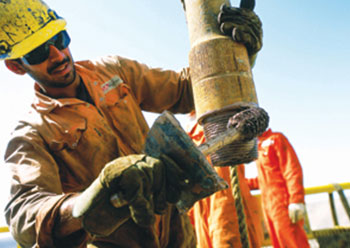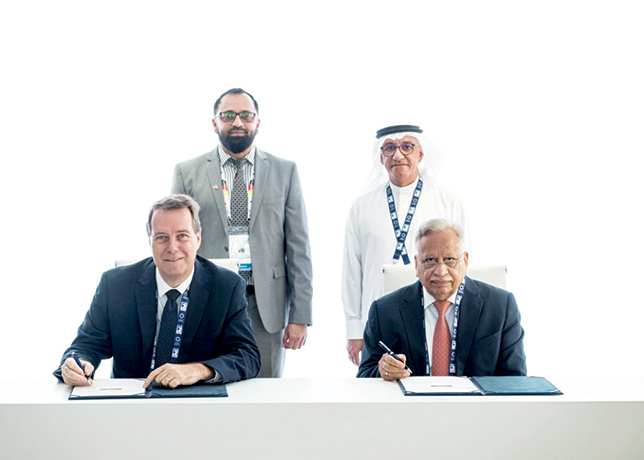
 A worker in the Fahud field
A worker in the Fahud field
Lekhwair is one of PDO’s largest fields with its oils mostly of 37.8[degrees] API from Lower Cretaceous Fms. The field’s development was completed in mid-1993, raising its capacity to 90,000 bpd, from about 26,000 bpd
Oman's oilfields hold the key to sustaining the role of the sultanate as a key oil and gas producer.
Nimr oil/gas field in the south found in 1980 produces 21[degrees] API oil from a Devonian Fm. A group of connected fields found later, including West Nimr, raised this system’s output to 180,000 bpd. But now their output is averaging 125,000 bpd. Their oil is heavy with high viscosity, as in the case of the Rima/Jalmud group. PDO in May 2011 gave the local Galfar Engineering and Contracting a $96 million job to develop the Nimr-G and Karim West oilfields. PDO was to build water-flooding facilities for both.
Nimr oil comes out of 1.2 mbpd of water. This and other groups of fields have a down-hole oil-water system which separates the water from the oil through a hydroclone. In early 2008, Al-Hassan Engineering got a $65 million job to drill 89 water production wells and 19 injection wells by 2010. Nimr had a gas compressor station contracted in 2009 and a sewage treatment system to pump effluent water from the well-head used to grow biofuel crops in the desert. PDO got the contractor to use desert greening technology there. The treated water is used for irrigation.
A biological solution was preferred as it was more environmentally friendly and did not require expensive gas feedstock. The system takes 45,000 cumd of water from the field, treats it and uses it to grow biodiesel. It is the first time such a project has been launched in the Middle East.
The treatment and disposal of water is a major issue for PDO. At some of its mature fields, PDO produces five barrels of water for every barrel of oil, compared with the industry standard of three to one.
The Nimr-Karim cluster of 18 small fields in the south have been developed by Medco-Energy of Indonesia under a PDO service contract (SC) won in January 2005. The fields then were producing about 18,000 bpd of crude oil. PDO on January 24, 2005, said: "The contract was awarded on the basis of a highly competitive tender in which suitable companies from Oman and across the globe participated."
The final SC was signed in March 2006. A new firm was then floated by MedcoEnergi and the state-owned OOC to execute the SC. OOC has 25 per cent in the new firm. Medco has maintained production at 18,000 bpd, preventing its decline as some of the fields began to fall in mid-2005. Medco has been committed to raise the fields’ production level to reach around 35,000 bpd in early 2015.
Fahud, found in 1963, is an oil and gas field in the north-central trend of the Arabian Basin like Yibal and Lekhwair. Fahud and Lekhwair have a joint oil production system with a capacity of 110,000 bpd, down from 140,000 bpd in early 2004 and 180,000 bpd in 1997.
A fractured field, Fahud has Lower and Middle Cretaceous Fms. The field’s area includes West Fahud to the north-west and its oil is of 32-33.6[degrees] API with 1.4-1.8 per cent sulphur.
Lekhwair, in the north found in 1968, is one of PDO’s largest fields with its oils mostly of 37.8[degrees] API from Lower Cretaceous Fms. The field’s development was completed in mid-1993, raising its capacity to 90,000 bpd, from about 26,000 bpd. But its current output is much lower. Lekhwair produces non-associated gas from a Shu’aiba Fm, which supplies the national grid with about 1.5 mcmd. The rest of its gas output is used for re-injection.
Together, Fahud and Lekhwair can produce 110,000 bpd.
PDO in September 2011 gave India’s Larsen & Toubro (L&T) a $150 million EPC contract for a gas treatment plant at Lekhwair. This has a single-train gas plant sending treated gas to a system at Yibal and condensate and water to the Lekhwair production centre.
 |
The Qarn Alam field |
The development projects have included construction of a gas de-sulphurisation and gas dehydration units. These have all the needed utilities, plus a remote mani-fold centre pumping liquids and gas supply pipelines.
Yibal, once the largest oilfield in Oman found in 1962, in 2018 is expected to produce 110,000 bpd of 38-40[degrees] API oil, from 135,000 bpd in early 2004 and 170,000 bpd in 1997. Yibal, Shell’s first discovery in Oman, also produces most of the country’s natural gas requirements. The field has Lower and Middle Cretaceous Fms at depths of 8,465 ft.
An expansion of Yibal to 200,000 bpd, from 120,000 bpd, was started in 1991 and completed in 1995.
Yibal now is backed by several satellite oil and gas fields. Together with Yibal, these form a single structure, with the Shu’aiba Fm being the main feature. Its expansions have involved the second phase of the Shu’aiba Fm’s development, tapping additional gas reserves.
Yibal also has non-associated gas reservoirs deep under the oil Fms. From them, most of Oman’s gas is produced:
Natih feeds the Government Gas System (GGS). Shu’aiba supplies the GGS with 1 mcmd, plus most of the gas PDO re-injects into its oilfields. Another major gas Fm feeding the GGS is Lekhwair. Yibal has a 16.5 mcmd processing plant and LPG producing units.
A down-hole oil-water separation system through a hydroclone was tried successfully at Yibal in 2001. The oil reaches the surface, while the water is re-injected into the reservoir. This achieves significantly higher oil production than a gas lift.
The Bahja-Rima-Jalmud fields in the south in 2016 was producing 80,000 bpd, from over 120,000 bpd in early 2004. Bahja is one of the latest fields in the south to be developed for this system.
Rima-Jalmud, found in 1979, had long been PDO’s second largest oil producer with a capacity of 90,000 bpd of 21-32.8[degrees] API viscous oils from a Paleozoic Fm at depths of 3,247 and 4,250 m. But output has fallen since 1997. North Jalmud was found in 1980.
Qarn Alam, a central Omani field, is one of PDO’s most difficult oil structures. Its capacity by 1997 had reached 100,000 bpd. But its output by end-2007 had dropped below 1,000 bpd.

















































































